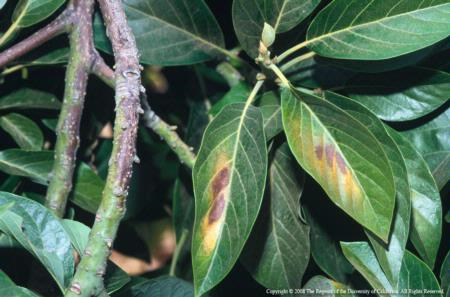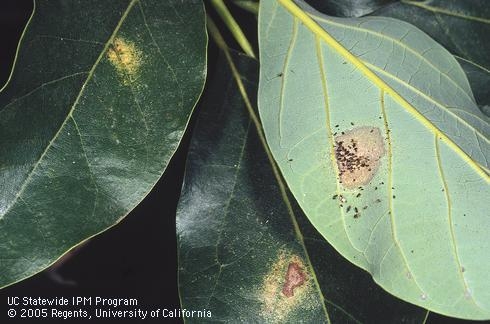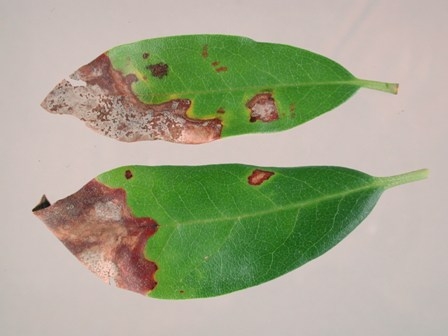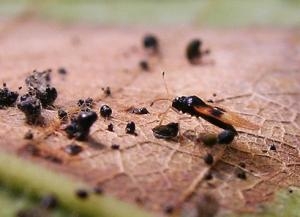
Posts Tagged: blight
When It Gets Hot, It Gets Confusing
So I got called out to see an orchard that had dieback. Over the phone it sounded like “Dothiorella Leaf Blight” (//ucanr.edu/blogs/blogcore/postdetail.cfm?postnum=10354). This symptom shows up when there has been water stress of some sort, over a period of a few weeks to months. 
It can be a branch or a whole tree. It usually is due to a watering schedule that doesn't meet the needs of the plant. It is exacerbated by competition from more aggressive plants nearby, like eucalyptus windbreaks. With increased competition over time, root rot can also start taking its toll because of the stress, as well. Where you see areas cleared of trees, and where there are struggling trees in various stages of survival, it's a good indication of a rough environment.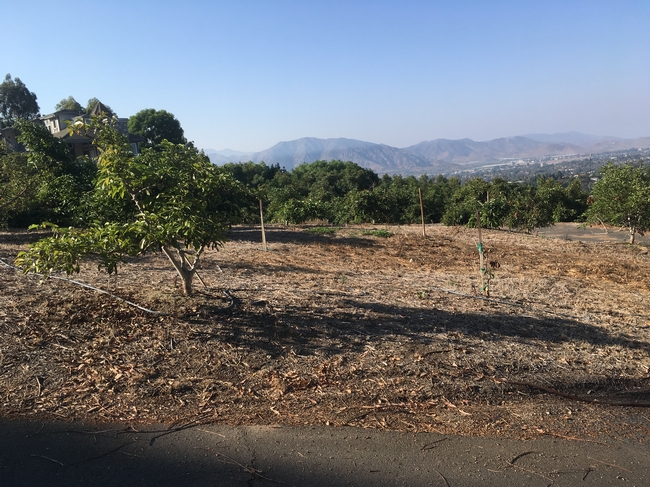
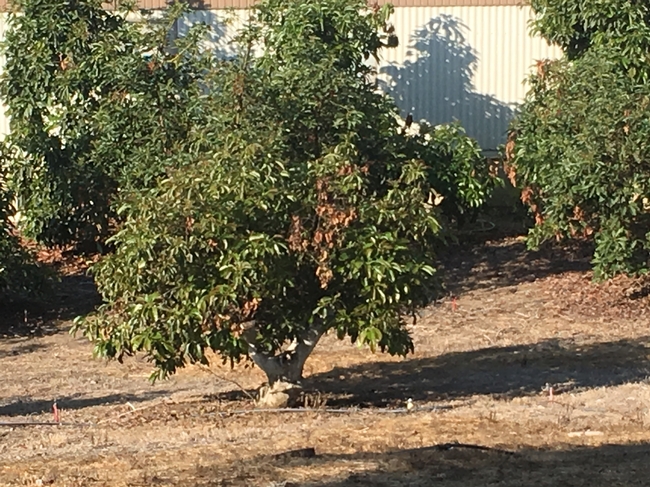
Trees with root rot symptoms may have been stumped previously, and with their weakened root systems are more prone to leaf blight.
In the case of this grove, it was at the top of the hill where it got all the wind and a full day's sun above the typical coastal fog.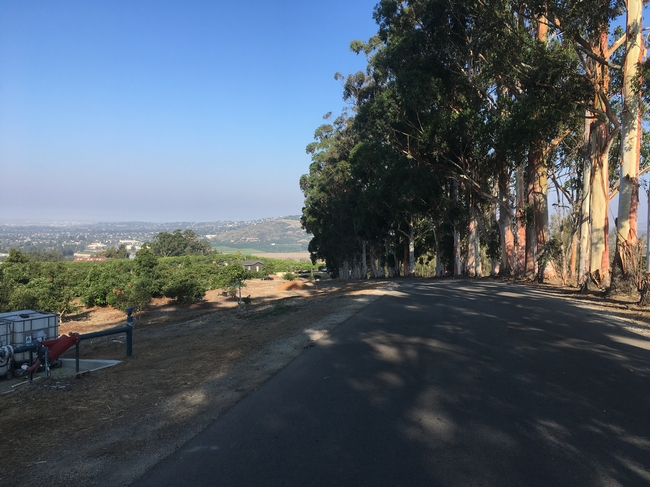
So the grower asked about the damage. There was the heat damage from the July heat wave.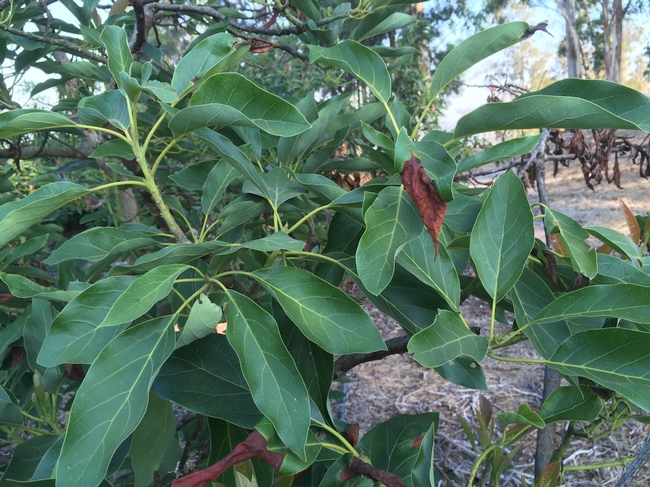
Then there was the damage that had showed up earlier, the leaf blight that was associated with the ongoing water stress. In a way, both of these symptoms are of water stress, one very rapid, hence the reddish tint to the leaves. The other a slower collapse, the leaf blight from prolonged water stress.
Over time, this type of stress had allowed root rot to take hold and trees were stumped in order to help them survive. The trees were also started on a regular phosphonate program. In general, the rest of the orchard looked good, except for this area near the competitive windbreak trees. The heat damage was mostly in this area, as well. The grower had been forewarned of the impending heat and irrigated the trees prior to the hard weather.
In the case of heat damage or blight, and leaf/stem blight, it's not fatal for mature trees. Younger trees under two years can be killed. They usually need whitewashing to prevent sun burn damage.
But even they can be revived if the watering is improved.
Avocado Lace Bug - ALB - Is Near You?
On October 5, 2017, the California Avocado Commission (CAC) was alerted to a possible infestation of avocado lace bug (ALB; Pseudacysta perseae) in commercial avocado groves in Oceanside and De Luz, San Diego County. UCR's Mark Hoddle confirmed the infestation. During his survey, Hoddle found all life stages of ALB in groves in both locations, indicating a well-established, reproducing population.
Avocado Lace Bugs are an introduced (who did it?) pest that was found in San Diego in 2004. Previously in the US, it had only been found in Florida. Their impact of avocados can be minor, or with explosive growth can cause significant defoliation. ALB has been known to be established in southern San Diego County for about 15 years, but only on backyard avocado trees. It appears that this is the first infestation of this pest in commercial groves.
Feeding damage occurs near mid-vein on lower leaf surface and appears as a yellow halo on the upper leaf surface.
Lace bugs restrict their feeding to the undersides of leaves, inserting their needle-like mouthparts into leaf tissue cells to extract cell contents. Feeding initially causes small white or yellow spots on the surface of the leaves as individual cells dry out. It is suspected that feeding damage can provide entrance for pathogenic fungi, in particular Colletotrichum spp., which are leaf anthracnose fungi. As lace bug colonies grow, brown necrotic (dead) areas develop where there has been heavy feeding damage. These necrotic areas look like tip-burn caused by salt damage, but in this case, the necrotic areas are islands of dead tissue in the interior of the leaf surrounded by living tissue. Heavy feeding can cause striking leaf discoloration and early leaf drop.Other signs of lace bugs are dark, varnish-like excrement and shed white nymphal skins on the undersides of leaves. Avocado lace bug nymphs and adults do not feed on fruit
Avocado lace bugs have only been reported feeding on avocado, red bay, and camphor, all members of the Lauraceae family. Experimental evidence from Florida indicates that avocado varieties vary in their susceptibility to feeding damage. West Indian x Guatemalan avocado hybrids appear to be particularly resistant to attack in Florida. Observations in the Dominican Republic indicate that Hass avocados (a Mexican-Guatemalan hybrid) can be severely damaged by lace bug outbreaks with occasional severe infestations causing defoliation and reduced yields.
It's important that we all keep our eyes open for this pest. It can easily be confused with salt burn or leaf blight damage, though. Looking for the insect which can be present all year round, the excrement pellets and the unusual yellow halo feeding symptom on the upper leaf surface are all good indicators that the insect is there. Leaf Blight fungus on the other hand has dead spots that appear on both upper and lower leaf surfaces and have wave effect as the fungus spread beyond the point of origin.
For complete details on identification, life cycle and management, you are encouraged to visit the UC IPM ALB webpage (http://ipm.ucanr.edu/PMG/PESTNOTES/pn74134.html).
Look for adults and excrement pellets
Leaf Blight caused by Botryosphaeria sp.
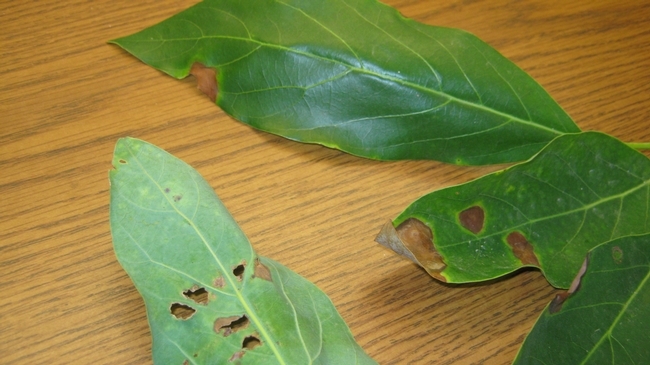
leaf blight damage
Water. Water. Water. And We Still Need to Learn How to Use It Right.
A recent grower survey in Santa Barbara County asked a whole bunch of questions. One of which was had they had an evaluation of irrigation distribution uniformity. This is a free service that can significantly improve on-farm water use and most importantly improve plant health. Avocados that don't get the right amount of water at the right time are extremely susceptible to root rot. Proper irrigation is the first line of defense against root rot, good farming that results in good economic returns to the grower.
So, with a free DU available to growers, how many do you think took advantage of the service? Barely 50%!!!!!!!! This just does not make sense. In a land of little water and frequent examples of what can happen with no water ………………..and high priced water, what is going on?
The local Resource Conservation District has done many system evaluations, and most results find that improvements can be made in distribution uniformity. This is true in relatively new irrigation installations. It does not take long for problems to occur in even well designed and installed systems.
During the summer of 2007, the Casitas Municipal Water District (CMWD) contracted with the Irrigation Training and Research Center (ITRC) of California Polytechnic State University, San Luis Obispo, to conduct field evaluations of drip/micro systems. A team of two students conducted 35 field evaluations.
Distribution Uniformity (DU) – DU is a measure of the uniformity of water application to trees throughout an orchard, with DU = 1.0 being perfect. The measured orchard DUs in the Santa Barbara/Ventura area had an average DU of 0.66, while the California state average for drip/micro is 0.85.
In general, there were substantial opportunities to improve the distribution uniformity (DU) of the water to trees throughout an orchard. An improved DU will minimize over-irrigation in some areas, and reduce under-irrigation in others. Key recommendations that were provided included:
Install a pressure regulator at the head of every hose
With a regular microsprinkler, doubling the pressure causes about 40 percent more water to come out of the nozzle. Pressure regulators are added to have similar pressures throughout the orchard and thus reduce the risk of over-irrigating portions of the field. On many farms, the difference between the highest pressures was double or even triple the lowest pressures (40-70% more water). By adding the correct high-quality, pre-set pressure regulators with the correct flow rate rating, the farmer can get similar pressures to every nozzle and prevent over-irrigation.
For a pressure regulator (PR) to work, more pressure must enter the PR than what the PR is rated for. For example, to use a 25 psi PR, you need at least 27 psi into the PR. All a PR does is reduce pressure; it cannot add pressure.
Another problem on hillsides is that some pipes have as much as 100 psi before the PR. A PR can effectively reduce the pressure down to 50%. What is recommended in these fields is to reduce the pressure in the pipe by adding an in-line valve halfway down the hill and throttling it down to a reasonable pressure.
Completely replace all microsprinkers with pressure compensating microsprinklers
Pressure compensating microsprinklers have an internal flexible diaphragm that reduces a pathway as the pressure increases. These allow similar amounts of water to get the trees even if the hoses do not have the same pressures. Whenever the pressure is doubled, 10 percent more water will come out of these emitters, compared to 40 percent more water with a regular microsprinkler. Having pressure compensating emitters can drastically improve the DU in virtually every avocado orchard because most irrigation systems were not properly designed for microsprinkler systems, or because the farmer has altered the original design by adding different-sized nozzles.
Reduce plugging problems
Major plugging problems are found in all orchards that did not have good filtration, even those that get district water. There were also some “within-system” causes of plugging. Almost all plugging is from simple dirt or rust, as opposed to bacteria or algae. Recommendations are as follows:
- Always have a filter at the head of the system. The required mesh size depends on the microsprinkler flow rate, but 120 mesh is a starting point.
- Remove hose screen washers that are found at the head of hoses, and replace them with regular washers (after installing a filter at the head of the system). The hose screen washers often plug up and cause the hoses to have unequal inlet pressures.
- Be sure to thoroughly flush hoses after any hose breaks.
- Double check the type of fertilizer that is being injected, especially any “organic fertilizers”. Some of these can plug emitters. In any case, inject the fertilizers upstream of the filters. If the filter plugs up, it is better to have discovered the problem early.
- Clean the filters frequently. Install pressure gauges upstream and downstream. When the pressure differential (as compared to a clean screen) increases by 3-5 psi, it's time to clean the screen.
In some orchards, there is a big plugging problem caused by insects crawling into emitters after the water is shut off. Many of the new microsprinkler designs utilize a self-closing mechanism to prevent insects from coming into the nozzle.
We have gotten a reprieve with the rains and refilled reservoirs, but it is ever more important to make sure our irrigation systems are doing what they are supposed to be doing. Call your local Resource Conservation District and get information about a system evaluation. Contact numbers can be found at: http://www.carcd.org/rcd_directory0.aspx
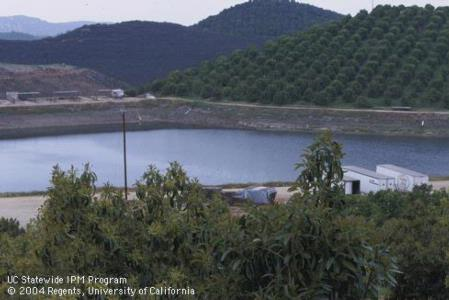
irrigation pond
Shoot and Twig Dieback of Citrus
Recently, an outbreak of shoot and twig dieback disease of citrus has been occurring in the main citrus growing regions of the Central Valley of California (Fig 1). The causal agents of this disease were identified as species of Colletotrichum, which are well-known pathogens of citrus and other crops causing anthracnose diseases. At this time, it is unclear how wide-spread the disease is in California citrus orchards, but surveys are being conducted to evaluate the spread of this disease in orchards.
The disease was first noticed in 2012 by several growers and nurserymen in various orchards in the Central Valley. Symptoms included leaf chlorosis, crown thinning, gumming on twigs and shoot dieback, and in severe cases, branch dieback of trees (Fig.2). The most characteristic symptoms of this disease are the gum pockets which appear on young shoots either alone or in clusters and the dieback of twigs and shoots (Fig.3). These symptoms were primarily reported from clementine, mandarin, and navel orange varieties. In order to determine the main cause of this disease, field surveys were conducted in several orchards throughout the Central Valley. Isolations from symptomatic plant samples frequently yielded Colletotrichum species.
Field observations indicate that symptoms initially appear during the early summer months and continue to express until the early fall. Trees showing dieback and gumming symptoms characteristic of this disease are usually sporadic within an orchard and generally only a few twigs or shoots are affected within a tree. Morphological and molecular phylogenetic studies allowed the identification of two distinct species of Colletotrichum (Colletotrichum karstii and Colletotrichum gloeosporioides) associated with twig and shoot dieback. Interestingly, these Colletotrichum species were also isolated from cankers in larger branches. Although C. gloeosporioides is known to cause anthracnose on citrus, a post-harvest disease causing fruit decay, it has not been reported to cause shoot dieback of citrus. C. karstii however has not been reported previously from citrus in California and our laboratory is currently conducting field and green house studies to determine the pathogenicity of this species in citrus.
At present, it is unclear how widespread this disease is in California orchards or how many citrus varieties are susceptible to this disease. Pest control advisors are advised to remain alert and monitor citrus trees for the presence of the disease in the Central Valley (particularly clementine, mandarin, and navel varieties) during the early summer months. Continuing research lead by Dr. Akif Eskalen (UC Riverside) in collaboration with Dr. Florent Trouillas (Kearney Agricultural Research and Extension Center), Dr. Greg Douhan (UCCE Farm Advisor Tulare County), and Craig Kallsen (UCCE Farm Advisor in Kern County) is focused on further understanding the biology of the fungal pathogens as well as factors influencing disease expression in order to develop management strategies against this emerging disease.
Shoot dieback symptoms on Clementine
Branch dieback symptoms on Clementine
Gumming symptoms on Clementine
(photos: A. Eskalen)
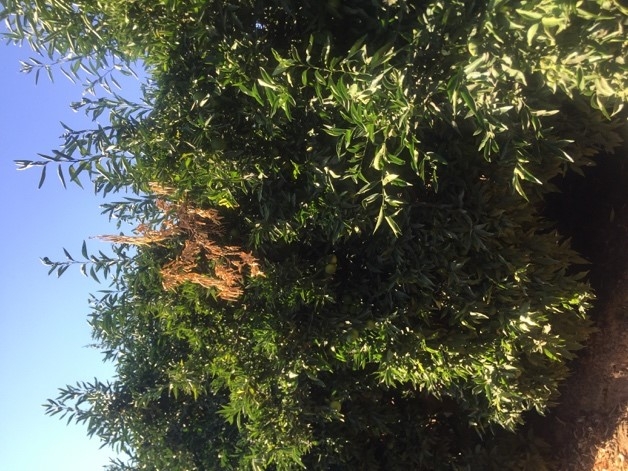
shoot dieback on clementine
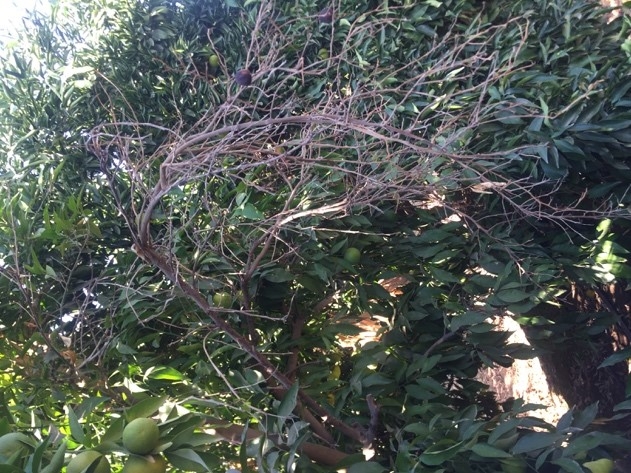
branch dieback on clementine
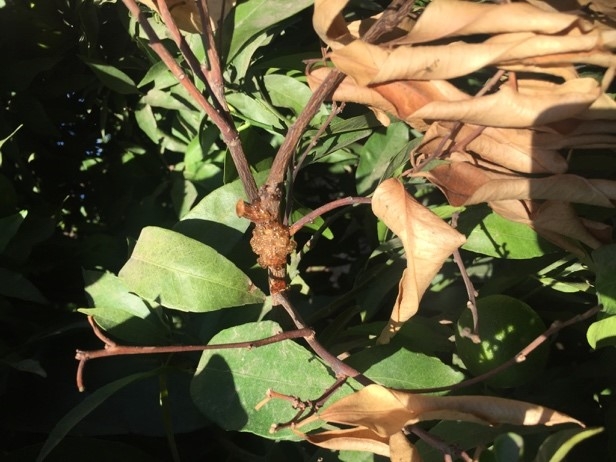
gumming symptoms on clementine
Drought Induced Problems in Our Orchards
Drought Induced Problems in Our Orchards
Abiotic disorders are plant problems that are non-infective. They are not caused by an organism, but through their damage, they may bring on damage caused by organisms. Think of a tree hit by lightning or a tractor. The damage breaches the protective bark which allows fungi to start working on the damaged area, eventually leading to a decayed trunk. It was the mechanical damage, though that set the process in motion.
Too much or too little water can also predispose a plant to disease. Think of Phytophthora root rot or even asphyxiation that can come from waterlogging or too frequent irrigations.
Salinity Effects from Lack of Water
Lack of water and especially sufficient rainfall can lead to salinity and specific salts like boron, sodium and chloride accumulating in the root zone. This happens from a lack of leaching that removes native soil salts from the root zone or the salts from the previous salt-laden irrigation from the root zone. These salts cause their own kind of damage, but they can also predispose a tree to disorders, disease and invertebrate (insect and mite) damage.
Lack of water and salt accumulation act in a similar fashion. Soil salt acts in competition with roots for water. The more soil salt, the harder a tree needs to pull on water to get what it needs. The first symptom of lack of water or salt accumulation may be an initial dropping of the leaves. If this condition is more persistent, though we start to see what is called “tip burn” or “salt damage”. Southern California is tremendously dependent on rainfall to clean up irrigation salts, and when rain is lacking, irrigation must be relied on to do the leaching
As the lack of leaching advances (lack of rainfall and sufficient irrigation leaching) the canopy thins from leaf drop, exposing fruit to sunburn and fruit shriveling.
Leaf drop and fruit shriveling in avocado.
In the case of sensitive citrus varieties like mandarins, water stress can lead to a pithy core with darker colored seeds, almost as if the fruit had matured too long on the tree.
Total salinity plays an important factor in plant disorder, but also the specific salts. These salts accumulate in the older leaves, and cause characteristic symptoms that are characteristic in most trees. Boron will appear on older leaves, causing an initial terminal yellowing in the leaf that gradually turns to a tip burn.
Often times it is hard to distinguish between chloride, sodium and total salinity damage. It is somewhat a moot point, since the method to control all of them is the same – increased leaching. There is no amendment or fertilizer that can be applied that will correct this problem. The damage symptoms do not go away until the leaf drops and a new one replaces it. By that time hopefully rain and/or a more efficient irrigation program has been put in place.
The Impact of Drought on Nutrient Deficiencies
Salinity and drought stress can also lead to mineral deficiencies. This is either due to the lack of water movement carrying nutrients or to direct completion for nutrients. A common deficiency for drought stressed plants is nitrogen deficiency from lack of water entraining that nutrient into the plant.
This usually starts out in the older tissue and gradually spreads to the younger tissue in more advanced cases.
The salts in the root zone can also lead to competition for uptake of other nutrients like calcium and potassium. Apples and tomatoes are famous for blossom end rot when calcium uptake is low, but we have also seen it in citrus. Low calcium in avocado, and many other fruits, leads to lower shelf life. Sodium and boron accumulation in the root zone can lead to induced calcium deficiencies and increased sodium can also further lead to potassium deficiencies. Leaching can help remove these competitive elements.
Drought Effect on Tree Disease
Drought and salt stress can also lead to disease, but in many cases once the problem has been dealt with the disease symptoms slowly disappear. They are secondary pathogens and unless it is a young tree (under three years of age) or one blighted with a more aggressive disease, the disease condition is not fatal. Often times, in the best of years, on hilly ground these diseases might be seen where water pressure is lowest or there are broken or clogged emitters. The symptoms are many – leaf blights, cankers, dieback, gummosis – but they are all caused by decomposing fungi that are found in the decaying material found in orchards, especially in the naturally occurring avocado mulch or artificially mulched orchards. Many of these fungi are related Botryosphaerias, but we once lumped then all under the fungus Dothiorella. These decay fungi will go to all manner of plant species, from citrus to roses to Brazilian pepper.
Another secondary pathogen that clears up as soon as the stress is relieved is bacterial canker in avocado. These ugly cankers form white crusted circles that ooze sap, but when the tree is healthy again, the cankers dry up with a little bark flap where the canker had been.
Drought Effect on Pests
Water/salt stress also makes trees more susceptible to insect and mite attack. Mites are often predated by predacious mites, and when there are dusty situations, they can't do their jobs efficiently and mites can get out of hand. Mite damage on leaves is often noted in well irrigated orchards along dusty picking rows
Many borers are attracted to water stressed trees and it is possible that the Polyphagous and Kuroshio Shot Hole Borers are more attracted to those trees.
And then we have conditions like Valencia rind stain that also appears in other citrus varieties. We know it will show up in water stressed trees, but we aren't sure what the mechanism that causes this rind breakdown just at color break. Could it be from thrips attracted to the stressed tree or a nutrient imbalance, it's not clear?
Water and salt stress can have all manner of effects on tree growth. It should lead to smaller trees, smaller crops and smaller fruit. The only way to manage this condition is through irrigation management. Using all the tools available, such as CIMIS, soil probes, soil sensors, your eyes, etc. and good quality available water are the way to improve management of the orchard to avoid these problems.
Scroll down for Images
Tip Burn, notice sun burn bottom right hand fruit
Endoxerosis with dried out core
Boron toxicity
Nitrogen deficiency
Blossom end rot
Potassium deficiency
Bot gumming in lemon
Black Streak in Avocado
Bacterial Canker
Citrus red mite
Polyphagous Shot Hole Borer damage on avocado
Valencia Rind Stain

avocado drought canopy
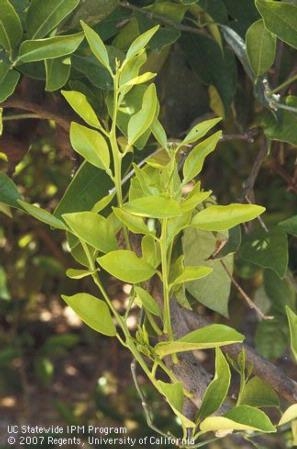
nitrogen deficiency

endoxerosis 4

boron toxicity citrus 1
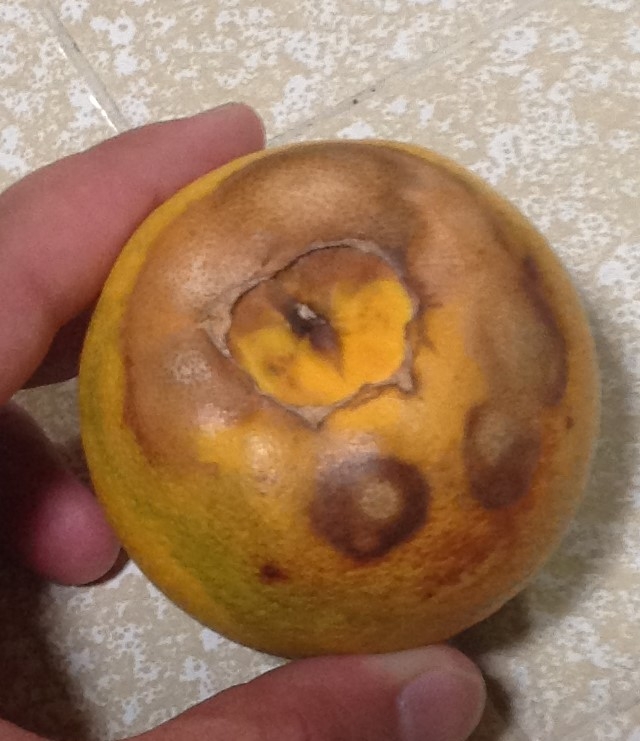
blossom end rot lemon

potassium deficiency avocado

gumming dothiorella

avocado black streak 1

bacterial canker avocado

citrus red mite

PSHB damage

